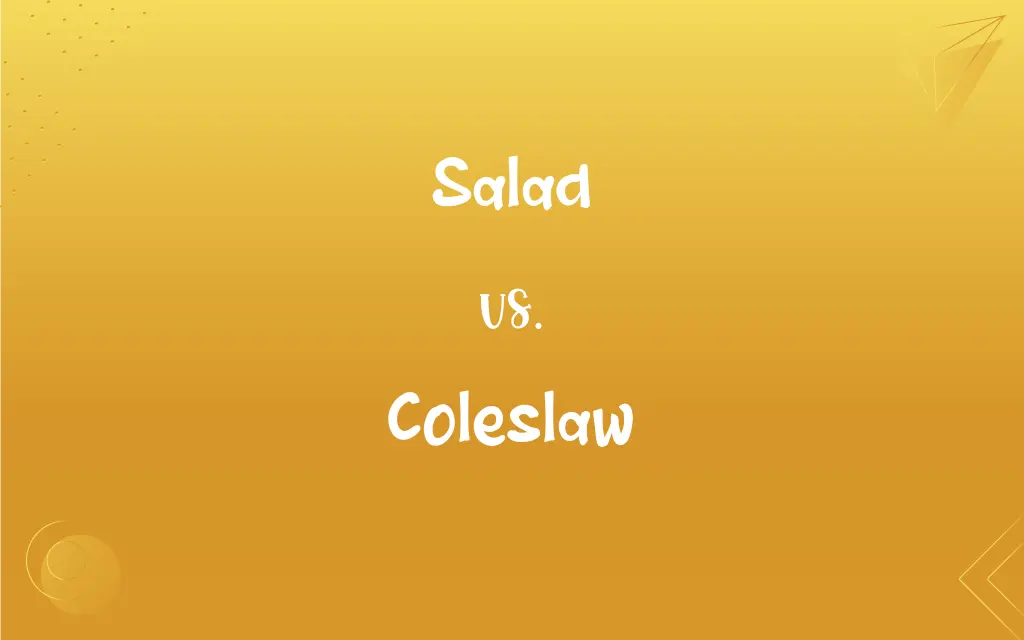Salad vs. Coleslaw: What's the Difference?
By Harlon Moss & Aimie Carlson || Updated on May 23, 2024
A salad is a dish consisting of mixed vegetables or fruits, often served with a dressing, while coleslaw is a specific type of salad made primarily from shredded cabbage and dressed with mayonnaise or a vinegar-based dressing.

Key Differences
A salad is a versatile dish made from a mix of various vegetables, fruits, proteins, grains, or other ingredients, typically served cold and often accompanied by a dressing. Examples include green salads, fruit salads, and pasta salads. Coleslaw, on the other hand, is a specific type of salad predominantly featuring shredded raw cabbage mixed with a dressing, which can be mayonnaise-based or vinegar-based. While salads can encompass a wide range of ingredients and variations, coleslaw is generally more uniform in its composition, focusing mainly on cabbage and sometimes incorporating carrots and other vegetables.
Salads can be served as appetizers, main courses, or side dishes and are valued for their nutritional variety and freshness. They can include ingredients such as lettuce, tomatoes, cucumbers, chicken, cheese, and nuts. Coleslaw is typically served as a side dish, especially at barbecues, picnics, and alongside fried foods, offering a crunchy texture and tangy flavor.
In terms of preparation, salads may require chopping, mixing, and dressing various ingredients, which can range from simple to complex recipes. Coleslaw preparation involves shredding cabbage and mixing it with a dressing, which is usually straightforward and quick.
The dressings used in salads can vary widely, including vinaigrettes, creamy dressings, and more, tailored to complement the specific ingredients used. Coleslaw dressings are more consistent, usually creamy mayonnaise-based or tangy vinegar-based, designed to enhance the cabbage's flavor.
Comparison Chart
Definition
Mixed dish of vegetables/fruits with dressing
Salad primarily of shredded cabbage with dressing
ADVERTISEMENT
Main Ingredients
Various vegetables, fruits, proteins, grains
Shredded raw cabbage, sometimes carrots
Common Dressings
Vinaigrettes, creamy dressings
Mayonnaise-based, vinegar-based
Typical Uses
Appetizer, main course, side dish
Side dish
Preparation
Chopping, mixing, and dressing various ingredients
Shredding cabbage and mixing with dressing
Serving Context
Wide variety of meals and occasions
Barbecues, picnics, alongside fried foods
ADVERTISEMENT
Salad and Coleslaw Definitions
Salad
A mixed dish of vegetables, fruits, proteins, or grains with dressing.
She made a fresh green salad with tomatoes and cucumbers.
Coleslaw
A type of salad made primarily from shredded raw cabbage.
The coleslaw was crunchy and refreshing.
Salad
Often accompanied by a dressing like vinaigrette or ranch.
The fruit salad was drizzled with a honey-lime dressing.
Coleslaw
Known for its crunchy texture and creamy or tangy flavor.
The creamy coleslaw balanced the spicy grilled chicken.
Salad
A dish often served cold, ideal for appetizers or sides.
The pasta salad was a hit at the picnic.
Coleslaw
Typically dressed with mayonnaise or vinegar.
She prefers coleslaw with a tangy vinegar-based dressing.
Salad
A versatile dish that can include lettuce, chicken, cheese, and nuts.
He prepared a hearty chicken Caesar salad for lunch.
Coleslaw
Commonly served as a side dish at barbecues and picnics.
Coleslaw is a classic accompaniment to pulled pork sandwiches.
Salad
Can be simple or complex, with endless ingredient combinations.
They enjoyed a simple garden salad with balsamic dressing.
Coleslaw
Often includes additional vegetables like carrots.
The coleslaw had shredded carrots and red cabbage.
Salad
A dish of raw leafy green vegetables, often tossed with pieces of other raw or cooked vegetables, fruit, cheese, or other ingredients and served with a dressing.
Coleslaw
A salad of shredded raw cabbage and sometimes shredded carrots, dressed with mayonnaise or a vinaigrette.
Salad
The course of a meal consisting of this dish.
Coleslaw
A salad of finely shredded raw cabbage and sometimes shredded carrots, dressed with mayonnaise (white slaw) or a vinaigrette (red slaw).
Salad
A cold dish of chopped vegetables, fruit, meat, fish, eggs, or other food, usually prepared with a dressing, such as mayonnaise.
Coleslaw
A salad made of sliced cabbage.
Salad
A green vegetable or herb used in salad, especially lettuce.
Coleslaw
Basically shredded cabbage
Salad
A varied mixture
"The Declaration of Independence was ... a salad of illusions" (George Santayana).
Salad
A food made primarily of a mixture of raw or cold ingredients, typically vegetables, usually served with a dressing such as vinegar or mayonnaise.
Chicken salad
We'd like a couple of cheese salads and two Pepsis, please.
Salad
A raw vegetable of the kind used in salads.
Salad
(idiomatic) Any varied blend or mixture.
Salad
A preparation of vegetables, as lettuce, celery, water cress, onions, etc., usually dressed with salt, vinegar, oil, and spice, and eaten for giving a relish to other food; as, lettuce salad; tomato salad, etc.
Leaves eaten raw are termed salad.
Salad
A dish composed of chopped meat or fish, esp. chicken or lobster, mixed with lettuce or other vegetables, and seasoned with oil, vinegar, mustard, and other condiments; as, chicken salad; lobster salad.
Salad
Food mixtures either arranged on a plate or tossed and served with a moist dressing; usually consisting of or including greens
FAQs
What are common ingredients in coleslaw?
Common ingredients in coleslaw include shredded cabbage and carrots.
What are common ingredients in a salad?
Common ingredients in a salad include lettuce, tomatoes, cucumbers, chicken, cheese, and nuts.
What is a salad?
A salad is a dish made from a mix of vegetables, fruits, proteins, or grains, usually served with a dressing.
What dressings are used in coleslaw?
Coleslaw is typically dressed with mayonnaise-based or vinegar-based dressings.
Is coleslaw typically a main course?
No, coleslaw is usually served as a side dish.
What dressings are used in salads?
Salads can be dressed with vinaigrettes, creamy dressings, and various other sauces.
How is a salad prepared?
A salad is prepared by chopping and mixing various ingredients and adding a dressing.
What is coleslaw?
Coleslaw is a type of salad made primarily from shredded raw cabbage mixed with a dressing.
How is coleslaw prepared?
Coleslaw is prepared by shredding cabbage and mixing it with a dressing.
What types of meals are salads commonly served with?
Salads are served with a wide variety of meals, from light lunches to hearty dinners.
Can salads be a main course?
Yes, salads can be a main course, especially when they include proteins like chicken or fish.
Can coleslaw be customized easily?
While coleslaw is somewhat more uniform in ingredients, it can still be customized with different dressings and additional vegetables.
Can salads be served warm?
Some salads, like warm potato salad, can be served warm, but most are served cold.
Is coleslaw ever served warm?
No, coleslaw is typically served cold.
What types of meals are coleslaw commonly served with?
Coleslaw is commonly served with barbecues, picnics, and alongside fried foods.
Are salads nutritious?
Yes, salads can be very nutritious, especially when made with a variety of fresh vegetables and lean proteins.
Is coleslaw nutritious?
Coleslaw can be nutritious, especially if it is made with a light dressing and plenty of fresh vegetables.
What is the origin of salads?
Salads have ancient origins, with variations found in many cultures around the world.
What is the origin of coleslaw?
Coleslaw originated in the Netherlands and is derived from the Dutch word "koolsla" meaning cabbage salad.
Can salads be customized easily?
Yes, salads are highly customizable with endless ingredient combinations.
About Author
Written by
Harlon MossHarlon is a seasoned quality moderator and accomplished content writer for Difference Wiki. An alumnus of the prestigious University of California, he earned his degree in Computer Science. Leveraging his academic background, Harlon brings a meticulous and informed perspective to his work, ensuring content accuracy and excellence.
Co-written by
Aimie CarlsonAimie Carlson, holding a master's degree in English literature, is a fervent English language enthusiast. She lends her writing talents to Difference Wiki, a prominent website that specializes in comparisons, offering readers insightful analyses that both captivate and inform.
































































